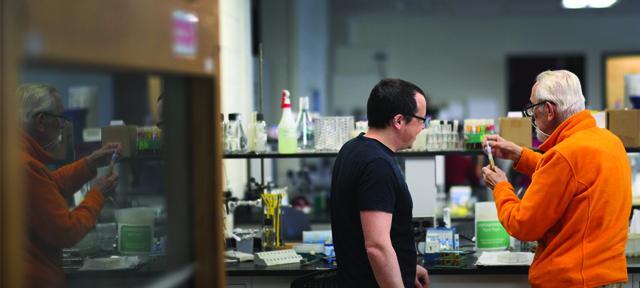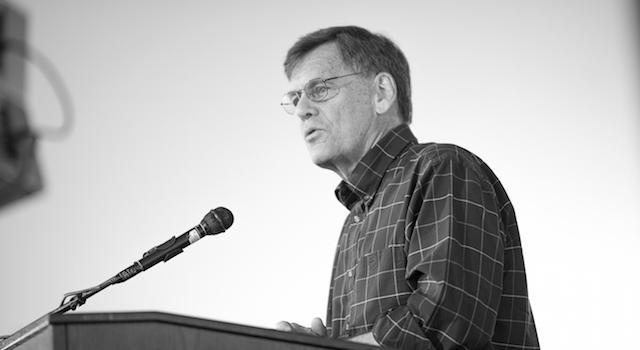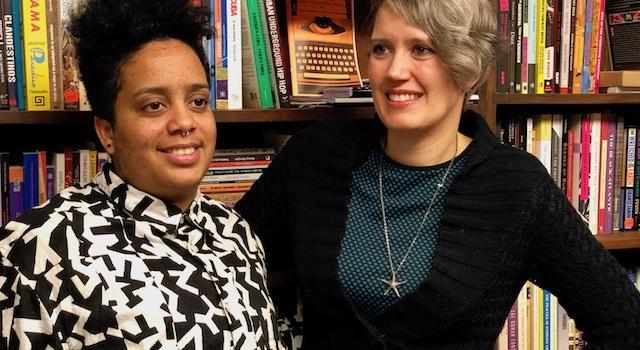"That's It," And He Left The Room: Lessons From a Veteran Professor

This is a series of conversations between faculty, one with decades of experience at Hampshire, the other fairly new to the College. Lynn Miller and John Castorino spoke together last spring, with a camera rolling, in Cole Science Center in one of the laboratory spaces that Lynn designed.
Lynn is professor emeritus of biology and one of Hampshire's founding faculty. His principal interests are genetics (human and microbial), molecular biology, and evolution. The description he wrote for his recent "Natural History of Infectious Disease" course begins: "Did you ever wonder why Jewish grandmothers who make gefilte fish from Norwegian sturgeon so frequently are parasitized by tapeworms? Maybe not, but who gets parasitized, when, and by what is highly significant to understanding the history of humankind. In this seminar we will read and think about the failure of modern (Western) medicine to eliminate most of the tropical diseases of Homo sapiens."
John is assistant professor of molecular biology whose research focus is examining the intracellular trafficking of the cancer-related protein CD147 and a family of monocarboxylate transporters. He writes, "Due to the excellent work of my students, a new trafficking partner of CD147 has recently been identified."
(Reprinted from the Fall 2016 Issue of Hampshire's Non Satis Scire Magazine)
Interviewer: You taught a course together, is that right?
John: Two courses, actually. "Human Gene Therapy" and "Gene Cloning."
Interviewer: Was this a shared area of research for you?
Lynn: John’s a molecular biologist and I’m a pretend molecular biologist.
————
Lynn: I was privileged as a graduate student at Stanford: one of the first courses I took was with C. B. van Niel, one great teacher. He was the first biologist to get the President's Medal, awarded by John F. Kennedy before he was assassinated. When van Niel went to Washington to receive the medal, in Kennedy’s memory, L.B.J. handed it to him and mispronounced photosynthesis. Anyway, I learned a great deal from van Niel, and much more about the teaching of science than I ever had before.
John: And I’ve learned from Lynn essentially how to teach science.
Lynn: We used to have a January term, three weeks long and the perfect opportunity for a lab course. In the first week our students would learn how to use the tools . . . pipettes, centrifuges . . . and how to run gels and handle themselves in a laboratory. At the end of that week, the instructors — I’d have several advanced students as instructors — would talk about their own projects, so students could then switch to working on a project that looked interesting to them. In three weeks we turned out polished, beginning molecular biologists. They could walk into a molecular biology lab anywhere in the country and be comfortable and do good work, right from the beginning. We got wonderful letters back from the faculty they were working with. They said, "Ah, you trained these kids well!" Because they knew how to handle themselves in the laboratory.
John: I took what I learned in those three weeks and turned it into a semester-long class. So what Lynn used to cram into three weeks, I now take a full term to do. I think we do it pretty well.
Lynn: I learned from van Niel that you can't teach anything unless a student is already interested in it. Rather than forcing them to choose a project that I designed, they choose their own. It makes them much more persevering.
John: At most colleges, if you want to do scientific research as an undergrad you go around and beg somebody to let you work in their lab. Here, when students design their own projects, in the process they wind up learning all the techniques required to answer the question that launched the project in the first place. It's an independent, immersive experience.
Lynn: And they’re working in small groups from the very beginning, which encourages them to work in groups during the rest of their college career. Much of science is so highly collaborative now, so they get an advanced test and touch of working together in groups.
————
John: The first class we taught together was Lynn’s "Human Gene Therapy: Proceed with Caution." Lynn ran that class in a very particular way, and not what I was used to, coming from a traditional institution. He gave assigned readings to students before they got to class and required them to come prepared with questions. He'd then start in with a lecture, on the spot, based on whatever their interests were for that day. The first time I saw this, no one had come prepared with questions. Lynn said, “Okay, that’s it,” and he left the room. The students were sitting there like, "What the hell's happening here?" I was sitting there like, "What the hell's happening here?" They learned quickly to get immersed in their readings and to start asking questions.
Lynn: I don't lecture them on stuff that's going to go in one ear and out the other. I want them interested in the material. It could be as trivial as terminology, so I'd go through a list of words. That would lead to more interesting questions, which I'd attack and try to get them engaged in discussion. That's the only way to get them to learn. They have to ask questions.
John: I use a similar technique in my "Art of Life" class. I have students perform lab experiments — but I don’t tell them what they're doing. They see the results but don't know the biological phenomenon that's happened in front of them. They don't know anything about what they're looking at. So they have to come up with a theory about what they're seeing, and ask questions about it. Then we'll discuss their questions and together we'll understand.
Lynn: We're trying to get them to learn by themselves, to teach themselves how to learn, so there will be no problem that they can't ever attack. When I'm reading some esoteric literature that's highly mathematical and I don't understand an equation, I go to a colleague down the hall, a mathematician or a physicist, and say, "How do you look at that equation?" They'll say, "Oh, that's easy! This is what you do." And I'll put it up on the board and graph it. That's something nobody ever taught me in college and it's really useful. So the next time, if I can't graph it, I go to them, and they keep on teaching me how to learn myself. That's the notion of having the students ask the questions and engage in work that nobody knows the answer to. Why would you want to spend all your time reading textbooks? Ugh! And memorizing them? Ugh! You want to get stuff that you don't know, that anybody else doesn't know, and try to figure out how to study it and how to think about it.
John: It's all about making a shift from students being information consumers to information producers and utilizers. I learned that from Lynn and from so many other professors here.
Lynn: I'll give you another example. A while back a new faculty member who was teaching with me designed a project for our students. He outlined it for me in detail . . . here's what they'll learn . . . it's wonderful . . . what do you think of that? "It's terrible!" I said. "What student did you have in mind?" And he got the message, right? You've got to get the students involved in that project, in designing it, thinking about it, and then you have them hooked.
John: You know, the way it usually works, you get that job in academia, you get your lab, you fill it with students who want to be a part of your research — Well, since I've been here, my whole focus has shifted. It's all about, How can I facilitate the students' interests? I do have that lab full of students, but they're working on lots of different things that may or may not have anything to do with my research interests. I feel like I'm helping train better scientists.
Lynn: Educate —
John: Educate, yes.
Lynn: Not train.
John: Yes. Yes.
Lynn: The open labs I designed facilitate that activity. I wanted them to be comfortable spots and safe places to work. We have a rule. In the beginning, when students are working in the lab, they have to have a partner. You can't be in here at night without someone else helping you or even just watching you. We've never had a bad accident in this lab. The notion is that it should be interesting and fun.
————
Interviewer: Can you talk about your areas of research?
John: Well, my own interests lie in how proteins move around inside cells. I'm trying to figure out how they move differently in cancer cells than in regular cells.
Lynn: Eye.
John: You?
Lynn: No, your eye.
John: Oh, yes, a lot of my work involves vision as well. I'm studying a family of transporters and, aside from their role in cancer, there's a lot that happens in the eye. The lens in your eye has critical functions with these proteins, so it's eye-focused general physiology as well.
Lynn: I'm also a geneticist. I've worked on the genetics of yeast saccharomyces, looking at sterol metabolism. The one major discovery of my life was to show that with the antibiotic mycostatin, which kills fungi when given at low doses, the yeast could become resistant to them. How does the yeast resist the low-level of mycostatin? I discovered that they had mutated one gene in the sterol pathway. I stopped that work because the biochemists took over. But now they knew how to get mutants for the sterile genes. I'm not particularly interested in biochemistry, unlike John, and so I said, "Ah, to hell with that," and I started to work on fish genetics. This was because I had a student who was interested in striped bass populations on the East Coast, and he had this crazy idea that many of the striped bass populations on the East Coast were actually coming down from Canada. I devised a method to look at genes involved in scales, and so I could use scales to isolate their DNA and measure where these fish came from. We did that for many years, but always, always, I was working with students who were devising their own varieties of problems far unrelated to the ones I was interested in.
John: You definitely develop closer relationships with your students here. I know all my former Div IIIs, and keep in regular contact with them. We talk almost monthly. It's interesting to see where they've taken their lives and what they're doing. It's just unreal, once they get a little bit of confidence here, they feel they can go out into the world and pretty much ask — and pursue — any question. A quick aside: I had a student who would sleep in class. He would just put his head down as soon as we began. He was a bright kid, but the material wasn't motivating for him. I said, "All right, let's just get through this class and next semester I'll do an independent study with you on whatever the heck you want to do." He wound up doing pretty well in the class, and next semester we talked about the independent study he wanted to work on. He brought me a primary research article that he found about how you can stimulate neurons using light, using a specific gene that somebody had just discovered. He had emailed the professor who came up with that technique, who agreed to send us some of his material so we could get working with it in the lab. This student went on to do some really great work. Having flexibility like that is really powerful. It made this particular student go from sleeping in class to getting his PhD in bioengineering.
Lynn: John is utterly amazing in the number of different projects his students are working on. Give a list, a short list.
John: Let's see. Of my Div IIIs this year, so we have someone working on induction of matrix metalloproteinases, with a question related to cancer and neuroscience. We have a student working in protein biochemistry, trying to do green chemistry using enzymes as opposed to harsh organic chemicals. We have another student working on protein trafficking on the inside of the cells and vesicles. I have another student interested in Ehlers-Danlos syndrome, and we've come up with some experimental models that she could develop with that. What else. Oh, I have another student interested in colorectal cancer who's taken on a project he started at an internship last summer. A lot of my former students will send me papers by email. "Check this out" or "You should incorporate this the next time you teach your class." Our ex-students are working on things I wouldn't have dreamed of ten or fifteen years ago, and they're really keeping us on our game.
Lynn: It's all about the students here. Full stop.
John: Yes.
Lynn: Because they've learned how to learn and how to do independent work. They don't rely on textbook answers.
John: I feel exactly the same way.
————
Interviewer: We're at a point of transition in the Hampshire faculty, veterans retiring and new professors being hired. What opportunity does that present for an institution?
John: I see it as more of a challenge, really. I’ve read a lot over the last few years about the founding of the College. When you have rapid turnover it can be hard to maintain the core values of founding faculty and make sure that the original goals stay instilled.
Lynn: That's why, in the School of Natural Science, every new faculty member must work with an experienced faculty member regardless of discipline. We hope there's a conjunction there, but they have to learn how Hampshire faculty encourage student learning. If we continue that, we won't have any problems.
John: I'm totally sold on the model. This is the way science needs to be taught — other finds as well.



